Key takeaways:
- Understanding homelessness involves recognizing the diverse factors and systemic issues behind each individual’s situation, highlighting the need for community engagement and collaboration.
- Identifying local leaders and building trustful relationships is essential for effective outreach and creating pathways for support.
- Successful collaboration requires ongoing dialogue, shared visions, and celebrating small wins, which fosters motivation and commitment to addressing homelessness.
- Sharing success stories and measurable outcomes not only inspires hope but also cultivates a sense of community accountability and transforms perceptions of homelessness initiatives.
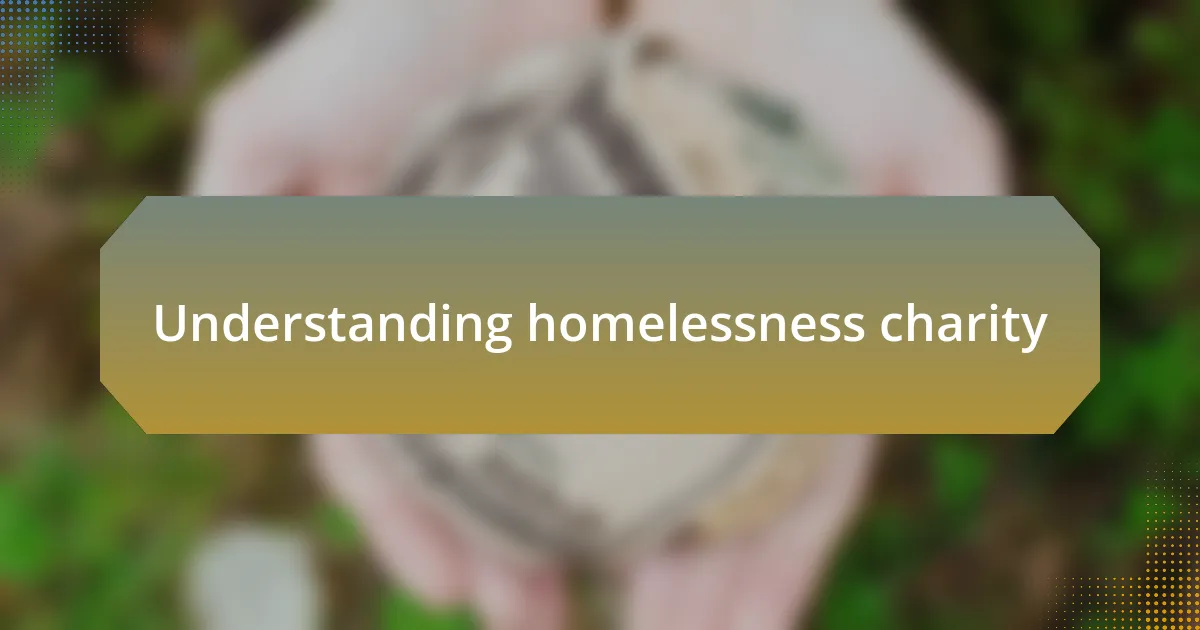
Understanding homelessness charity
When I first delved into the world of homelessness charity, I was struck by how complex the issue truly is. It’s not just about providing shelter; it’s about understanding the diverse stories behind each person’s situation. Have you ever considered the myriad factors that lead someone to find themselves without a home, from job loss to mental health struggles?
I vividly remember meeting a local leader who shared their journey of starting a homelessness charity. They spoke passionately about the relationships built with individuals in crisis. Their eyes lit up when recalling a young man who, after receiving support, went on to find a stable job and even mentor others facing similar struggles. Isn’t it inspiring to think about the potential change just one supportive connection can spark in someone’s life?
The emotional weight of homelessness can be overwhelming, not only for those affected but also for those of us looking to help. I found that engaging with local leaders helped me understand the systemic issues at play. It begs the question: how can we come together as a community to address these root causes? By listening and collaborating, we can create lasting change that goes beyond immediate relief.
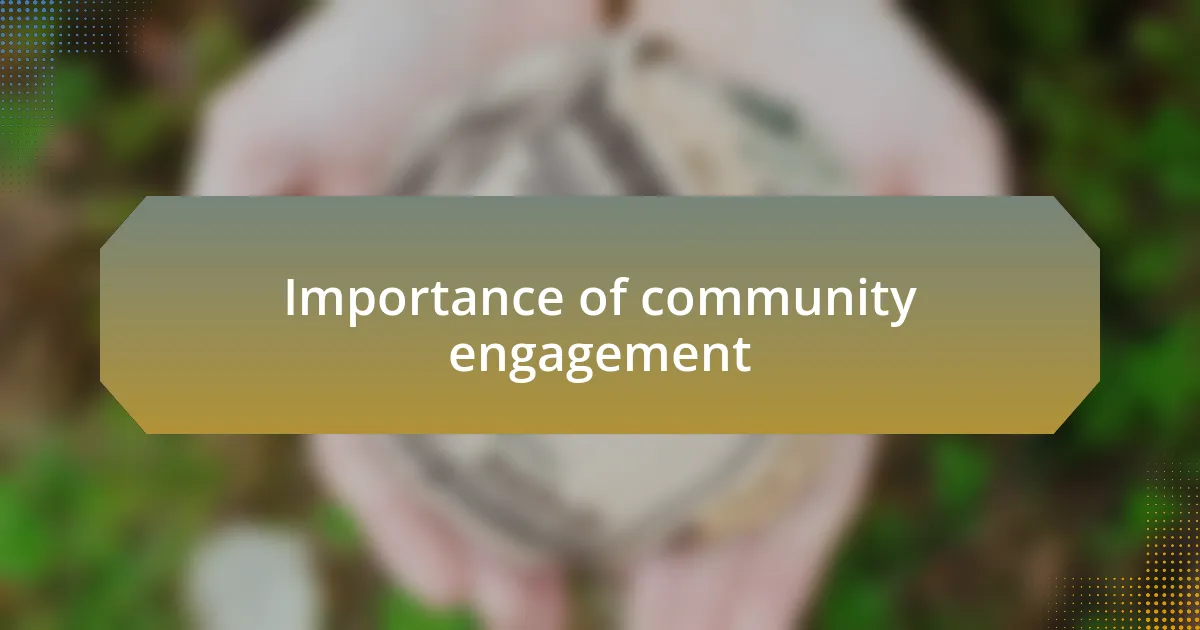
Importance of community engagement
Engaging with the community is crucial in addressing homelessness effectively. I recall a community meeting I attended where local residents voiced their concerns and ideas, sharing their connections to individuals experiencing homelessness. This was a powerful reminder that community members often hold key insights. Have you ever thought about how much local knowledge can shape solutions?
The beauty of community engagement is its ability to foster trust. When I interacted with local leaders who had established strong connections, it was clear how essential these relationships were in facilitating support systems. For instance, I watched as a leader who had previously experienced homelessness became a bridge between service providers and those in need, helping to create pathways for services that were previously unseen. Isn’t it remarkable how shared experiences can cultivate compassion and understanding?
Moreover, fostering community collaboration often leads to innovative approaches to tackling homelessness. During one outreach event, I witnessed how diverse groups – local businesses, schools, and volunteers – came together to create a resource fair. It was inspiring to see firsthand how collective efforts not only provided immediate relief but also built a sense of solidarity and purpose among participants. How often do we miss opportunities to maximize our combined strengths for a greater cause?
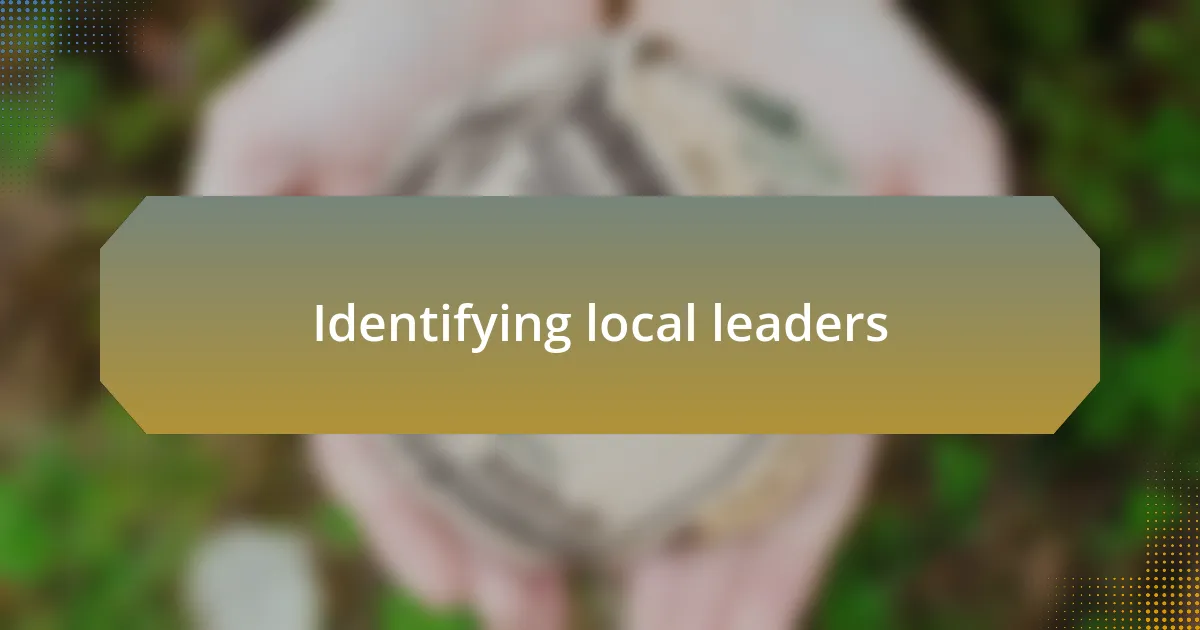
Identifying local leaders
Identifying local leaders begins with observing who people naturally gravitate towards in times of need. I remember attending a meeting where a local restaurant owner spoke about how they fed neighbors experiencing homelessness; community members listened intently, nodding as if confirming a shared trust in their leadership. It struck me then – these informal leaders often emerge in the most unexpected places, driven by passion and compassion.
Another effective way to identify leaders is through established networks within the community. I once partnered with a local social service agency, and they helped pinpoint individuals who actively engaged in advocacy. These leaders were not just figures in the community; they were connectors, actively bringing people together. How might your outreach efforts benefit from tapping into these existing relationships?
Furthermore, I found that observing interactions at local events can reveal leaders in action. During a weekend food drive, I noticed a quiet but determined individual mobilizing volunteers and coordinating logistics behind the scenes. Their passion radiated through the crowd, and it made me realize that true leadership often manifests in the desire to uplift others. Have you ever encountered someone who quietly yet powerfully influences their community without seeking the spotlight?
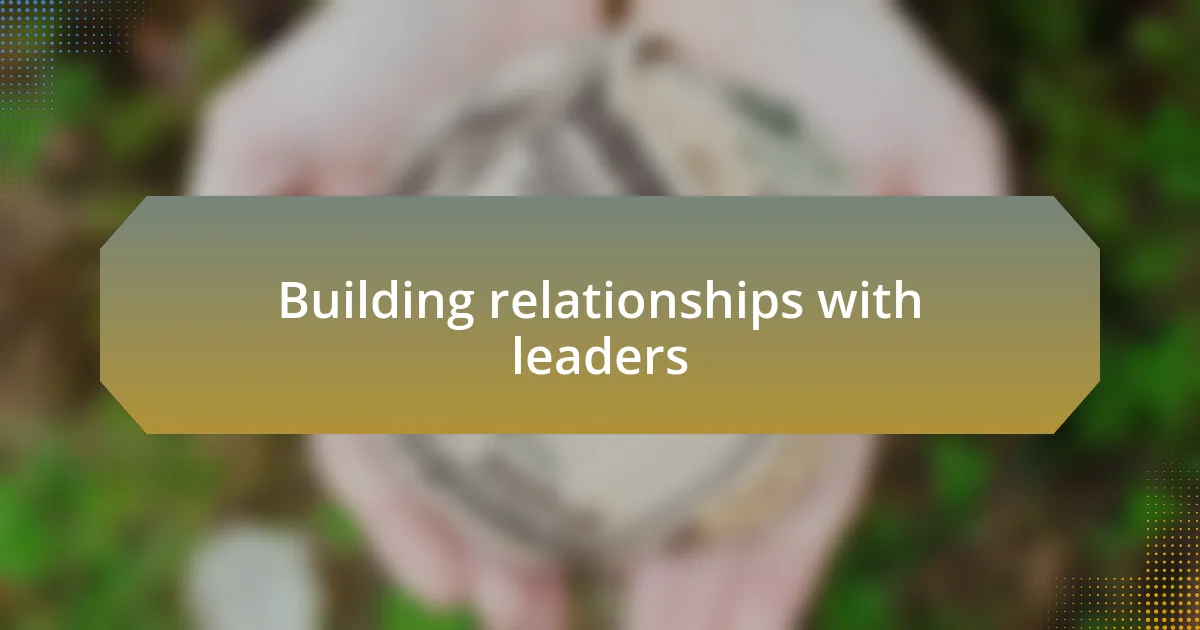
Building relationships with leaders
Building relationships with local leaders involves more than just recognizing their influence; it’s about nurturing trust and open communication. I remember reaching out to a community organizer after hearing them speak at a town hall meeting. We bonded over our shared commitment to addressing homelessness, and that conversation laid the groundwork for future collaborations. Have you ever thought about how a simple dialogue could spark impactful change?
One approach I found effective is to invite leaders to participate in workshops or collaborative initiatives. I once hosted a brainstorming session with various stakeholders, where we brainstormed solutions for homelessness. The energy in the room was palpable as ideas flowed and friendships formed. Seeing leaders engage with each other and share their visions was incredibly inspiring; it reinforced how vital collaboration is in achieving meaningful goals.
I also learned the power of regular follow-ups. A few months back, I checked in with a local council member I had met previously. Our discussion revealed their insights on policy changes affecting the homeless population. This connection not only deepened our relationship but also enhanced my understanding of the broader challenges we face. How often do you maintain those connections after the initial meeting? It’s the ongoing dialogue that truly fosters a strong network.
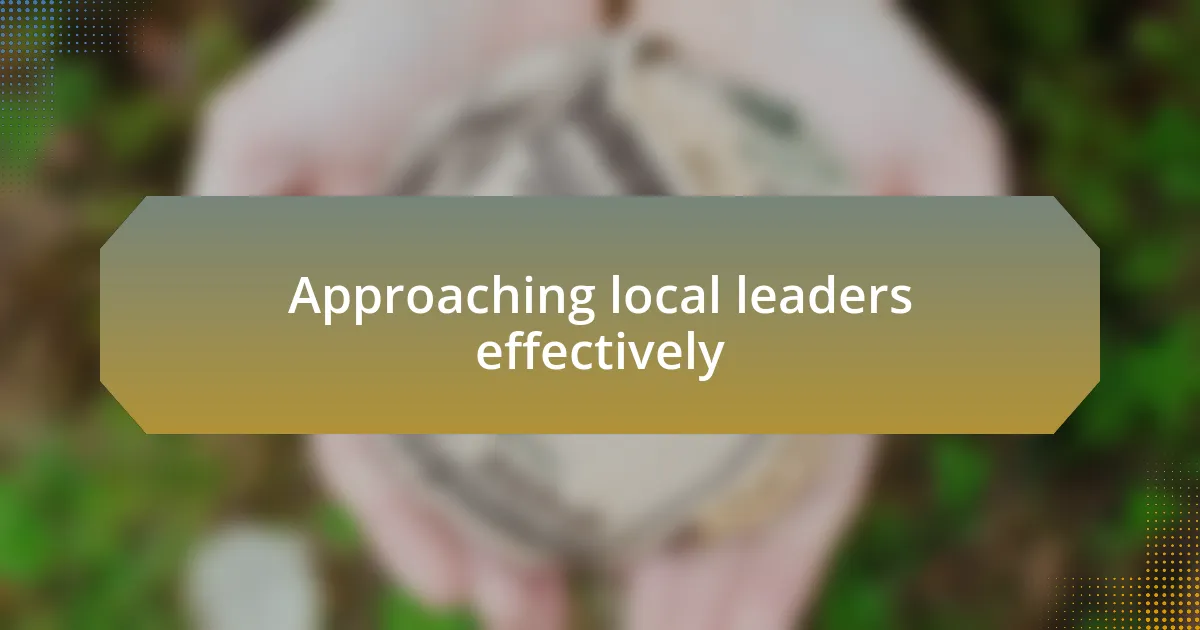
Approaching local leaders effectively
To approach local leaders effectively, timing is crucial. I remember a moment when I attended a community event focused on local issues. I seized that opportunity to introduce myself to a city council member. By aligning our conversation with the context of the event, I created a natural flow that made it easier for them to engage with my ideas around homelessness.
Listening actively plays a pivotal role as well. During a one-on-one meeting with a local leader, I let them speak first about their initiatives. This not only showed my genuine interest but also helped me identify where our goals intersected. Have you ever tried simply listening first? It can open unexpected doors and lead to fruitful partnerships.
Additionally, being prepared with data and anecdotes about the local homelessness situation can make your outreach more impactful. For instance, I once shared a compelling story about a young person experiencing homelessness right in our community. This personal touch made it easier to connect on an emotional level, highlighting the urgency of the issue. It’s amazing how personal narratives can prompt leaders to re-evaluate their priorities, isn’t it?

Collaborating on homelessness initiatives
Collaborating on homelessness initiatives often thrives through shared visions. I recall participating in a roundtable discussion where various local leaders expressed their ideas for tackling homelessness. Each leader brought unique perspectives, and by weaving together these insights, we crafted a comprehensive approach that addressed not just immediate needs but also the underlying causes of homelessness in our community. Isn’t it fascinating how a simple conversation can transform into a collective movement?
Engagement doesn’t end with meetings; it’s essential to follow through with tangible actions. After a fruitful dialogue with a local nonprofit, I organized a volunteer day where community members could experience firsthand the challenges faced by those experiencing homelessness. Witnessing the participation and enthusiasm of volunteers made me realize that hands-on collaboration can ignite passion and commitment, driving initiatives forward.
In my experience, celebrating small wins can significantly strengthen these partnerships. I remember when our collaborative efforts resulted in securing a basic needs pantry for those in crisis. Highlighting that achievement brought our teams closer and motivated us to tackle the next challenge together. Have you considered how celebrating progress can boost morale and encourage further collaboration? It’s rewarding to see how acknowledging successes fuels our dedication to the cause.
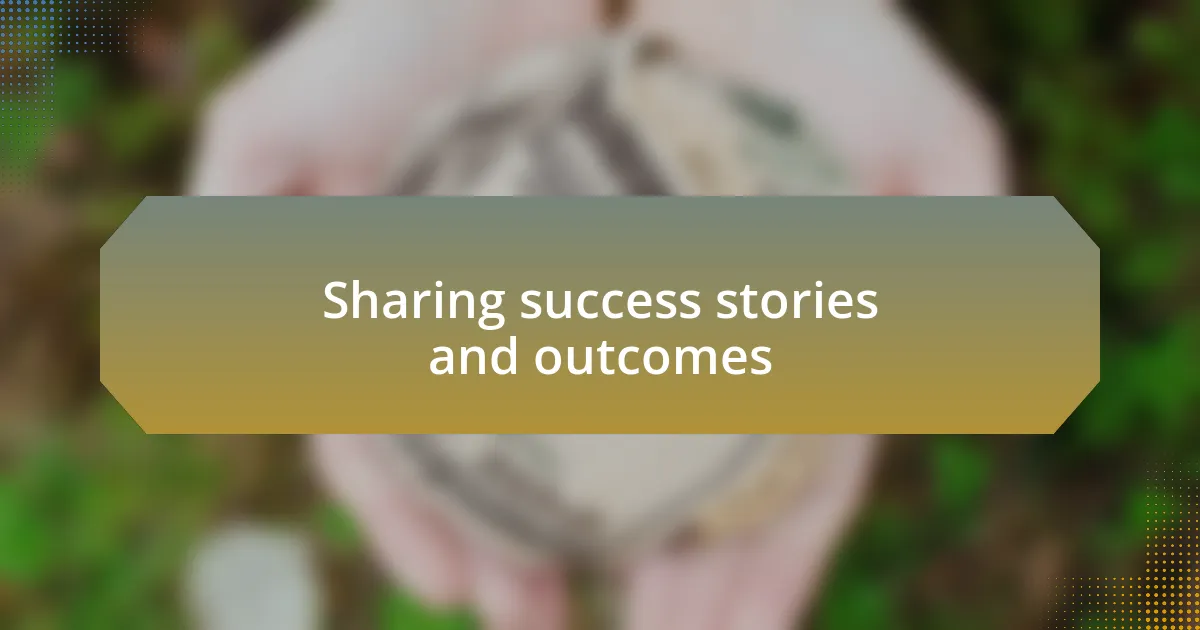
Sharing success stories and outcomes
Sharing success stories isn’t just about patting ourselves on the back; it’s about fostering hope in our community. I recall a time when we highlighted a family that had transitioned from living in a shelter to securing stable housing. This story resonated deeply with local residents and motivated many to contribute to our ongoing initiatives. Doesn’t it feel empowering to see real people benefiting from our efforts, reminding us of the tangible impact we can make together?
In another instance, we showcased how a job training program helped several individuals find meaningful employment. The pride on their faces during the graduation ceremony was infectious, igniting a spark within our organization and beyond. It made me reflect: how often do we share these stories that not only reflect our successes but also inspire others to join the fight against homelessness?
When we transparently share outcomes, such as statistics on reduced homelessness rates linked to our programs, it validates all our hard work. I remember presenting these results at a community event, where tears of joy and applause mingled with heartfelt conversations about next steps. It struck me then how these shared victories can cultivate a sense of accountability and hope. Have you ever considered how sharing such outcomes can transform not just perceptions, but also hearts?